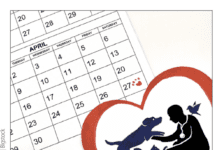

© wrangler | Bigstock
People who lose a cat often experience what social workers have called disenfranchised grief, says veterinarian Karen Fine, a graduate of the Cummings School of Veterinary Medicine at Tufts. By which she means that the grief one feels upon losing a pet often is not considered socially acceptable and is given short shrift by others. “‘You’re still upset?'” people will ask cavalierly, Dr. Fine says. “That was a couple of weeks ago.” They don’t realize that people often have a closer bond with their cat than they do with many of the other loved ones in their lives, caring for their pet every single day and developing a daily rhythm through feeding the animal, perhaps sleeping in the bed with her, enjoying quiet kneading sessions, goofy antics, and being greeted by their pet when coming home from work.
The devastating loss coupled with a lack of outlets to express the grief leaves people feeling even worse. That’s why Dr. Fine suggests that they write an obituary for their cat, even if some time has passed since the pet died. It can prove a very therapeutic exercise, and therefore a healing and cathartic one.
How to get started
In her “Guide to Writing a Pet Obituary” (karenfineDVM.com), Dr. Fine offers a number of writing prompts to help people get started. For instance, “how and when did you first meet your pet? What mischief did your pet get into? How did they make you laugh? And what was your favorite part of your daily routine with your pet?” By answering these questions in writing, she says, remembering your pet becomes “something positive,” something that “helps you smile through your tears a little bit and say, “they were here; they had an impact on my life.”
Also, Dr. Fine says, preparing an obituary gives you something to do to honor your pet other than just put away the food bowls and the scratching post and the toys — acts that will make you think of the death more than the joy your cat gave you.
For those who don’t like to write
Dr. Fine acknowledges that not everybody is a comfortable writer and should not pressure themselves, and says there are other ways to create an obituary.
“It can be in any form,” she points out. It can be a poem, for instance, or a slide show you create with photos and then sit down to watch with your family or others who understand. (In that instance, the process of creating becomes both an obituary and a kind of memorial service.)
Other options are for several people to put together an obituary as a group. “You can sit down as a family,” Dr. Fine says, “and pass around a piece of paper on which each person writes their thoughts. Children can be part of this, too.” That way, she says, the remembrance has the stamp on it of all those who were closest to the cat and would feel the loss most keenly. It allows family members to grieve with each other as supportively as possible.
Even a little shrine to your cat — a photo of the pet with perhaps a favorite toy, other mementos, and maybe even a votive candle — can be a kind of obituary, a way of saying, this being changed my life for the better, and I want to honor my cat and remember why I loved her so much even while I feel sad.
There is no right or wrong way to go about it, Dr. Fine emphasizes. If you do an actual write-up, you can write it a little at a time or all at once. You can type it or put it down on longhand — whatever works. However you do it, by honoring your pet, you will be honoring the validity of the very strong emotions you may be feeling as well as your very real relationship with your beloved friend.
A Sampling of Obituaries
NEADY Cats, a no-kill shelter in Central Massachusetts, allows people who have adopted cats from the facility to place obituaries on its site in its “Memorial Tributes” section. “The idea came about because people kept writing to us and telling us all about their cats after they died,” says Marilyn Sarkisian, who runs the shelter.
“Sometimes I don’t hear from people for 20 years.” Then their cat dies, and it’s “a way for people to get over the loss. It helps them heal. So we said, let’s put this up” so “people can grieve and let go.”
Following are snippets from some of the entries.
“Some cats ease their way into your heart. Milo barreled his way in….He greeted all visitors by running up to them and chewing on their shoes — or toes if they were barefoot!…Eating around Milo was an experience. He loved pizza and Chinese food and would do anything to get this food, including knocking the fork out of my hand. He would sit on his haunches and wave his paws in the air for teriyaki beef….The house is so quiet without him.”
“When I was just 10 years old, my mother and I adopted Friskey….From that day forward I had a best friend for life. I am 26 years old now, and…Friskey passed away just last week…he lived long enough to meet my daughters and became a best friend to them as well….My life will not be the same without him.”
“Eddie…took his breakfast on the kitchen table each morning as I read the newspaper. He had a glass of water (he preferred a glass instead of a bowl), and I had my coffee. Then we would share toast with butter….I could go on and on about our precious Eddie….He was our one in a million.”
To see more obituaries, go to neadycats.org, click on the “NEADY Cats” tab and then the drop-down “Memorial Tributes” sub-tab.





Fantastic beat ! I would like to apprentice while you
amend your website, how could i subscribe for a blog website?
The account aided me a acceptable deal. I had been a little bit acquainted of this your broadcast provided bright clear
concept